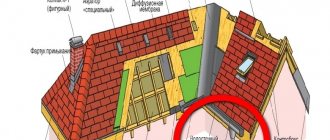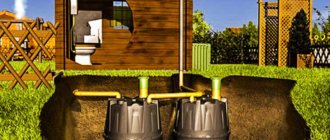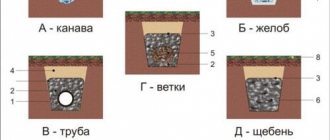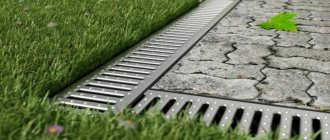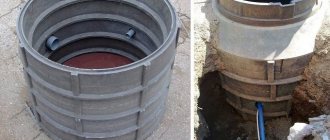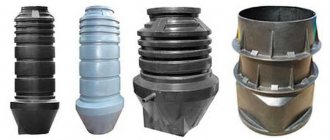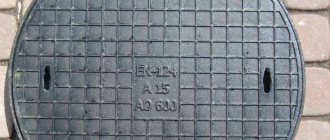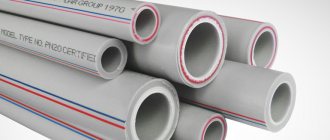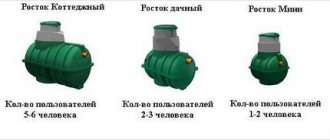The drainage system plays an important role in any type of building. The principle of rainwater drainage is clearer than daylight - it is responsible for the redistribution and removal of precipitation , which is presented in a liquid state or has become so.
The objects protected by the drain are the façade, foundation, and roof.
The functioning scheme of a sloping place is based on the location of funnels (the number will be determined by the individual characteristics of the project), which “receive” liquid precipitation and, through appropriate pipes with or without contours, transport water to the place designated for drainage.
What is a gutter and what does it represent?
When it comes to storm drainage components, one of the first things that comes to mind is the gutter. Of course, the absence of this channel will not call into question the creation of a drainage system, but from year to year, the failure or abolition of this component in the entire water drainage structure can result in a number of troubles.
Here are the main tasks that a gutter performs:
- responsible for the direction of movement of water that flows from the surface of the building;
- minimizes water penetration and negative impacts on the foundation;
- eliminates the possibility of erosion of multi-component dynamic systems in the area where the house is located;
- significantly reduces the volume of water that penetrates into the basement;
- preserves the facade and various decorative and architectural objects in a diligent form, counteracting their destruction thanks to the correct and coordinated drainage of precipitation.
To all the listed advantages, you can also add the possibility of collecting rainwater thanks to the gutter and other elements of the drainage system in special containers that are placed at the final drain.
IMPORTANT!
Rainfall collection is a very pressing issue for houses and summer cottages with land plots allocated for vegetable gardens, flower beds, etc., since in the warm season, if watering is necessary, you will have the opportunity to rationally use the accumulated precipitation.
Visually, the supply channel resembles a “half” pipe, somewhat open at the top. It is usually installed along the side of the building from corner to corner. There are absolutely no restrictions on the choice of material for the manufacture of this component of a sloping structure, and lead, cast iron, painted steel or aluminum, copper and even wood are used as a kind of raw material.
What is a gutter?
Composition of the drainage system
In addition to the gutter, the rainwater drainage system includes the following elements:
- The drainpipe provides vertical transportation of atmospheric residues received from the gutter or funnel. The main function of the element is to effectively remove water accumulations from the canopy of the house. As a rule, it is presented in the form of a prefabricated structure, but depending on the project, simplified options can be used;
- pipe connector , as a rule, is part of the drainpipe or can be an auxiliary part of the supply channel. Its main purpose is expressed in the name itself. To a greater extent, the element is used to connect main pipes or a composite pipe with a branch (as well as angles). Also used in cases where it is necessary to adjust the length of the drainpipe;
- The bracket serves as a support for the aqueduct and fastening directly to the surface of the house . They come in two types. The first of them is called short and its main task is to maintain the necessary parameters for proper drainage. The second type, which is a long holder, is presented as a power structure with the function of forming and regulating the slope of the drainage system;
- the gutter plug provides water insulation of the edge of the channel , which does not provide for the connection of a pipe and corresponding system elements in a given corner of the building;
- The clamp performs the function of fixing the drainage riser to maintain the specified direction of fluid movement . Visually it looks like a ring, which, thanks to a pin, is attached to the wall;
- drainage funnels collect and direct accumulated sediment into a composite pipe;
- The drain acts as a “crossing” between the liquid drain and the place (container) for its disposal.
Drainage system design
Also, when installing rainwater drainage, additional components can be used, such as tees (spread pipes), bypasses (bypass “protruding” areas of the building) and special protective walls that prevent various debris, leaves and other foreign objects from entering the riser.
What material are they made from?
There are three main types of materials that are most suitable for these purposes. The main selection criterion will be the ability to withstand precipitation and temperature changes. There is also a tendency to choose stormwater systems that match the windows and walls of the building . This important detail will give a harmonious appearance to the building and will not look like an alien element against its background.
What material is used:
- Polymer compounds, usually the common polyvinyl chloride (PVC). Main advantages: light weight and affordable cost. Disadvantages include heating under the sun's rays, which can lead to deformation and the risk of damage during heavy precipitation, such as hail or the weight of snow. Estimated service life is 50 years. For hot climate zones, white plastic is usually used; in temperate zones, brown is also suitable. There are varieties of green, brick and black colors.
- Cink Steel It is distinguished by its large weight and good quality construction, so the fastenings must be appropriate. Homemade gutters are usually made from galvanized steel, but purchased options can also be purchased from this material. The service life will be around 10–15 years, and then with fairly good care. The annual inspection should include timely removal of dirt and debris. Despite the “stainless” characteristics, galvanized steel is prone to corrosion, so the service life of such gutters is relatively short.
- Copper storm systems - the highest quality and most prestigious option. The service life is approximately 100 years, while such systems have a more complex configuration and usually form a harmonious composition with the roof, which is also made from this material. High strength and performance characteristics also have their drawbacks, the main one being the significant price. Such a system must also be taken into account when planning the building, since the serious weight of the structure requires additional reinforcement.
It is quite difficult to determine the best manufacturers on the domestic market, because special research has not been conducted in this area. Among the most competitive companies, the following categories can be distinguished:
- "Metalloprofile" (Russia);
- "Grand Line" (Russia);
- "Aquasystem" (Russia);
- Lindab (Sweden);
- "Marley" (Germany);
- "Docke" (Germany);
- "Profil" (Poland);
- "Bryza" (Poland);
- Hunter Plastics (UK);
- Murol (a joint venture between Japan and Canada).
As you can see, the choice is quite large, so purchasing suitable products is a matter of time and financial investment.
Gutter: dimensions and role of slope
Actually, there are not so many classifications separating different types of this element. Most often, supply channels are distinguished depending on the material of manufacture.
Thus, we should talk about:
- metal. As in any other situation, the main reason for choosing metal is rigidity and reliability . Thanks to their individual properties, guides can last 30-40 years. Resistant to mechanical stress;
- plastic. In this case, there are advantages - lightness and immunity to corrosion . But on the other hand, their disadvantages are due to low strength and poor sound insulation;
- concrete. They were developed during the construction of high-rise buildings and the installation of sidewalk drainage systems. Due to its significant weight, it is not used in “home” construction . In addition, the stone is not such an effective competitor to water loads in the long term.
NOTE!
The choice in favor of metal gutters should be based on the expected load on the roof and foundation structure . Steel will add significant stress to the outer edges of the walls and rafter system.
Another characteristic by which modern gutters are usually distinguished is their cross-section. Based on this characteristic, channels are divided into rectangular, square and round. Visually, all this can be understood immediately, hence the names in the classification.
As for the features and feasibility of using one type or another, rectangular drainage systems are used in regions where there is a large amount of precipitation . At low humidity parameters, square gutters are fixed, while round ones are generally considered universal.
Gutter slope
The length of the gutter is equal to that of the eaves of the house. Their number is determined for each slope separately. As for the width of the channels, this value depends on the area of the roof. Below are the proportions based on the example of the Profil drainage system instructions.
On the left is the roof area, on the right is the width of the drainage pipe:
- one riser at the edge: up to 70 sq. m - 90 mm, 70-140 sq. m - 130 mm;
- one riser in the center: up to 110 sq. m - 90 mm, 110-200 sq. m - 130 mm;
- two risers at the edges: up to 140 sq. m - 90 mm, 140-220 sq. m - 130 mm
In addition to the size of the structure, pay attention to the slope.
CAREFULLY!
The slope of the depression is very important, since if the position is too flat, part of the liquid will not be transported to the composite pipe, and if the slope is large, the flow of water will be incommensurate with the capabilities of the funnels. The slope of the gutter is 3-5 mm per linear meter.
DIY gutter installation
This procedure can be entrusted to professionals, but since you are already up to date and familiar with the features of this element, it is quite possible to lead this process yourself.
In particularly difficult situations, you will need to place an order for parts and for this you will need drawings.
Let's give an example of installing a channel from Murol. All requirements and regulatory data are taken from SNiPs and GOSTs.
First of all, you need to pay attention to the installation of holders.
To do this, you need to determine the diameter of the bracket.
The condition is the following - this value should be slightly larger than the gutter circumference . The interval between the hooks is up to 90 cm, but if the structure is metal, then the figure can be increased to 1.2-1.5 m. Also, auxiliary fastenings at the corners will not hurt.
Installation of brackets
At the next stage, we select the slope. The optimal slope of a gutter per 1 meter is approximately 1-2 mm . There is another option - install the gutter brackets in the corners, the second one should be lower. Then take the rope and pull it between the holders.
Thanks to this simple action, you will get a clear line for attaching the remaining brackets.
IMPORTANT!
Some types of roofing may require a greater slope.
After fixing the hooks, we move on to the funnels. Their number depends on the area of the roof (up to 10 meters - 1, further more) . In addition, in this matter, pay attention to the angle of the slope.
The roof cut should extend to the center (no further) of the funnel , otherwise water runoff will simply pour over the edges and a small portion will be directed to the riser. Plugs will also be useful in the design, which will reduce the likelihood of leakage to a critical minimum.
Bracket installation step
If desired or necessary, it is possible to create special rotating elements. Thanks to these auxiliary parts, the area of the drainage system will be significantly reduced.
In such conditions, tees and elbows are especially useful, as they will ensure the distribution of wastewater and turn it into a coherent and efficient process. And finally, the finishing knee is installed.
Gutter installation
Actually, the installation process is not quite as simple as it seems. Whether you take on this matter yourself or turn to specialists is up to you, and we will provide the necessary assistance.
Types of trays used
A concrete tray can be different in shape, configuration, appearance, strength, purpose and other parameters. According to the method of installation, trays can be telescopic (elements are installed one inside the other, draining water from embankments, bridges along a slope) and edge trays (usually installed in a cascade or along roads at a single level).
Types of trays by section shape:
- Trapezoidal - assume telescopic installation, made in a trapezoid format.
- U-shaped - designed to drain minor volumes of water, an ideal choice for a private household.
- U-shaped - have the largest cross-sectional area and are used for installing systems with heavy loads.
Based on the material used, gutters can be made of concrete, with the addition of polymers and a sand mixture.
Concrete
The strongest and most durable products can withstand external loads ranging from 60 to 90 tons. They are made from cement and fillers, can be reinforced, come in different colors (if pigment is added to the concrete), and come in a huge variety of shapes and sizes.
Concrete gutters are often used to install systems for draining stormwater and melt water into sewers.
Polymer concrete
They simultaneously have the properties of plastic and concrete waste. They are made from granite chips and quartz sand with special epoxy and polyester resins. Cement is replaced by polymer compounds, which makes the structure resistant to various types of chemical elements.
Due to the inclusion of plastic, the product is light in weight, which makes installation and creation of the entire system easier. Often such drains are used in private housing construction, equipped with gratings.
Polymer sand
Such gutters are the most modern and technologically advanced solution. The effluents have high plasticity rates and an extremely long service life. They are made from polymer chips with special sand of a very fine fraction.
In terms of strength, drains are in no way inferior to concrete products, but have minimal weight, which significantly speeds up and simplifies installation.
